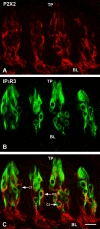Immunocytochemical analysis of P2X2 in rat circumvallate taste buds
- PMID: 22621423
- PMCID: PMC3507709
- DOI: 10.1186/1471-2202-13-51
Immunocytochemical analysis of P2X2 in rat circumvallate taste buds
Abstract
Background: Our laboratory has shown that classical synapses and synaptic proteins are associated with Type III cells. Yet it is generally accepted that Type II cells transduce bitter, sweet and umami stimuli. No classical synapses, however, have been found associated with Type II cells. Recent studies indicate that the ionotropic purinergic receptors P2X2/P2X3 are present in rodent taste buds. Taste nerve processes express the ionotropic purinergic receptors (P2X2/P2X3). P2X2/P2X3(Dbl-/-) mice are not responsive to sweet, umami and bitter stimuli, and it has been proposed that ATP acts as a neurotransmitter in taste buds. The goal of the present study is to learn more about the nature of purinergic contacts in rat circumvallate taste buds by examining immunoreactivity to antisera directed against the purinergic receptor P2X2.
Results: P2X2-like immunoreactivity is present in intragemmal nerve processes in rat circumvallate taste buds. Intense immunoreactivity can also be seen in the subgemmal nerve plexuses located below the basal lamina. The P2X2 immunoreactive nerve processes also display syntaxin-1-LIR. The immunoreactive nerves are in close contact with the IP(3)R3-LIR Type II cells and syntaxin-1-LIR and/or 5-HT-LIR Type III cells. Taste cell synapses are observed only from Type III taste cells onto P2X2-LIR nerve processes. Unusually large, "atypical" mitochondria in the Type II taste cells are found only at close appositions with P2X2-LIR nerve processes. P2X2 immunogold particles are concentrated at the membranes of nerve processes at close appositions with taste cells.
Conclusions: Based on our immunofluorescence and immunoelectron microscopical studies we believe that both perigemmal and most all intragemmal nerve processes display P2X2-LIR. Moreover, colloidal gold immunoelectron microscopy indicates that P2X2-LIR in nerve processes is concentrated at sites of close apposition with Type II cells. This supports the hypothesis that ATP may be a key neurotransmitter in taste transduction and that Type II cells release ATP, activating P2X2 receptors in nerve processes.
Figures






References
-
- Kinnamon JC, Yang R. Ultrastructure of Taste Buds, In: “The Senses: A Comprehensive Reference” G. Beachamp (ed.) Elsevier (New York) 2007.
Publication types
MeSH terms
Substances
Grants and funding
LinkOut - more resources
Full Text Sources

